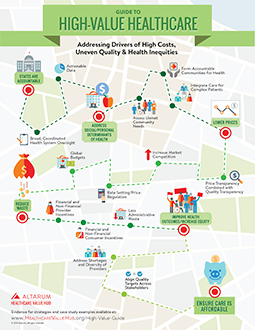Guide to High-Value Healthcare: Addressing Drivers of High Costs, Uneven Quality and Health Inequities
Achieving a patient-centered, high-value healthcare system requires an evidence-based understanding of (1) the drivers of high costs, uneven quality and health inequities and (2) the strategies that counteract those drivers. This high-level guide helps advocates, policymakers and others navigate this evidence.
As discussed below, we recommend a comprehensive approach to achieving a patient-centered, high-value healthcare system. However, these recommendations don’t have to be enacted in sequential order, as long as they fairly reflect conditions at the state and local level.
 |
States are Accountable Healthcare value problems (and solutions) vary depending on a state’s unique populations and local market conditions. As healthcare regulators and payers, state governments play a critical role in helping their health systems function. Nonetheless, too few take a coordinated, systematic approach to ensuring that residents get value for the money they spend. A small number of states have a central oversight authority that focuses on reducing healthcare costs, improving quality, bringing spending in line with overall economic growth and implementing innovations for better value. Additionally, most states lack critical data and analysis capacity needed to customize the solutions for their healthcare market. Our resources can help! |
|
 |
Address Social/Personal Determinants of Health Failure to address social determinants of health is the largest contributor to wide disparities in health outcomes. Healthcare, public health and social services must work together to fully address the goals and needs of the people they serve. Our policy roadmap outlines the many policy changes needed to accomplish this goal. Examples include: |
|
|
Decrease High Unit Prices Rising unit prices are our most important cost driver, accounting for the majority of year-over-year increases in per capita medical spending. Strategies to lower unit prices include:
|
||
 |
Reduce Waste Contrary to popular belief, high utilization of services does not drive our high healthcare spending. Nevertheless, evidence is clear that many services could be eliminated with no harm to patients -- saving money. At the same time, increasing the use of high-value services -- like tobacco cessation, flu vaccines and certain preventive screenings -- improves outcomes and saves money down the road. Strategies to reduce waste include: |
|
 |
Improve Health Outcomes/Increase Equity All of the strategies above will contribute to better health outcomes for consumers. But additional steps should be taken to ensure that all people have equal opportunity to lead healthy lives. Strategies to make our healthcare system more equitable include:
|
|
 |
Ensure Care is Affordable Addressing social/personal determinants of health, decreasing high unit prices, reducing waste and improving equity are critical to achieving a high-value, patient-centered healthcare system. But these actions alone will not guarantee that healthcare is affordable for consumers, particularly those who lack insurance or are under-insured. Strategies to improve healthcare affordability include:
|







